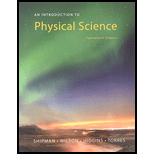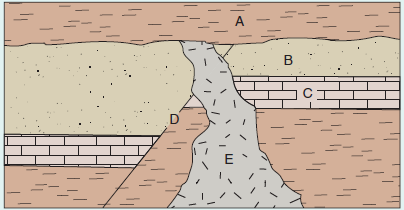
Bundle: An Introduction to Physical Science, 14th Loose-leaf Version + WebAssign Printed Access Card, Single Term. Shipman/Wilson/Higgins/Torres
14th Edition
ISBN: 9781305719057
Author: James Shipman, Jerry D. Wilson, Charles A. Higgins, Omar Torres
Publisher: Cengage Learning
expand_more
expand_more
format_list_bulleted
Concept explainers
Textbook Question
Chapter 24, Problem 4E

Figure 24.21 Relative Dating See Exercises 3 and 4.
4. Refer to Fig. 24.21.
- (a) Which is younger, the rock stratum C or the fault marked D? What geologic principle did you use?
- (b) Which is younger, the fault marked D or the igneous intrusion marked E? What geologic principle did you use?
Expert Solution & Answer
Trending nowThis is a popular solution!

Students have asked these similar questions
No chatgpt pls will upvote
No chatgpt pls will upvote
No chatgpt pls
Chapter 24 Solutions
Bundle: An Introduction to Physical Science, 14th Loose-leaf Version + WebAssign Printed Access Card, Single Term. Shipman/Wilson/Higgins/Torres
Ch. 24.1 - Are dinosaur footprints fossils?Ch. 24.1 - Prob. 2PQCh. 24.2 - Prob. 1PQCh. 24.2 - Prob. 2PQCh. 24.2 - Prob. 24.1CECh. 24.2 - Prob. 24.2CECh. 24.3 - Prob. 1PQCh. 24.3 - Prob. 2PQCh. 24.3 - Prob. 24.3CECh. 24.4 - Prob. 1PQ
Ch. 24.4 - Prob. 2PQCh. 24.5 - Prob. 1PQCh. 24.5 - Prob. 2PQCh. 24.5 - Prob. 24.4CECh. 24 - KEY TERMS 1. geologic time (Intro) 2. fossil...Ch. 24 - KEY TERMS 1. geologic time (Intro) 2. fossil...Ch. 24 - Prob. CMCh. 24 - Prob. DMCh. 24 - Prob. EMCh. 24 - Prob. FMCh. 24 - Prob. GMCh. 24 - Prob. HMCh. 24 - Prob. IMCh. 24 - Prob. JMCh. 24 - Prob. KMCh. 24 - Prob. LMCh. 24 - Prob. MMCh. 24 - Prob. NMCh. 24 - Prob. OMCh. 24 - Prob. PMCh. 24 - Prob. QMCh. 24 - Prob. RMCh. 24 - Prob. SMCh. 24 - Prob. TMCh. 24 - Prob. UMCh. 24 - Prob. VMCh. 24 - Prob. WMCh. 24 - Prob. XMCh. 24 - Prob. ZMCh. 24 - Prob. 1MCCh. 24 - Prob. 2MCCh. 24 - Prob. 3MCCh. 24 - What is the name for the type of fossil formed...Ch. 24 - Prob. 5MCCh. 24 - What is obtained when rocks and geologic events...Ch. 24 - Prob. 7MCCh. 24 - Prob. 8MCCh. 24 - Prob. 9MCCh. 24 - Prob. 10MCCh. 24 - If the half-life of a radioactive specimen is 100...Ch. 24 - Prob. 12MCCh. 24 - Prob. 13MCCh. 24 - Prob. 14MCCh. 24 - Prob. 15MCCh. 24 - Prob. 16MCCh. 24 - Prob. 17MCCh. 24 - Prob. 18MCCh. 24 - Prob. 19MCCh. 24 - Prob. 20MCCh. 24 - Prob. 1FIBCh. 24 - Prob. 2FIBCh. 24 - Prob. 3FIBCh. 24 - Prob. 4FIBCh. 24 - Prob. 5FIBCh. 24 - Prob. 6FIBCh. 24 - Prob. 7FIBCh. 24 - Prob. 8FIBCh. 24 - Prob. 9FIBCh. 24 - Prob. 10FIBCh. 24 - Prob. 11FIBCh. 24 - Prob. 12FIBCh. 24 - Prob. 13FIBCh. 24 - Prob. 14FIBCh. 24 - Prob. 15FIBCh. 24 - Prob. 16FIBCh. 24 - Prob. 17FIBCh. 24 - Prob. 18FIBCh. 24 - Prob. 19FIBCh. 24 - Prob. 20FIBCh. 24 - What is meant by the phrase geologic time?Ch. 24 - Why are so few fossils of worms found?Ch. 24 - Prob. 3SACh. 24 - Prob. 4SACh. 24 - Prob. 5SACh. 24 - Prob. 6SACh. 24 - Prob. 7SACh. 24 - Prob. 8SACh. 24 - How do fossils aid in oil exploration?Ch. 24 - Prob. 10SACh. 24 - How might the principle of superposition be...Ch. 24 - Prob. 12SACh. 24 - Prob. 13SACh. 24 - Prob. 14SACh. 24 - Prob. 15SACh. 24 - Prob. 16SACh. 24 - What four features characterize the best index...Ch. 24 - Prob. 18SACh. 24 - Prob. 19SACh. 24 - Prob. 20SACh. 24 - Prob. 21SACh. 24 - Prob. 22SACh. 24 - Prob. 23SACh. 24 - Prob. 24SACh. 24 - Prob. 25SACh. 24 - Prob. 26SACh. 24 - Carbon-14 dating measures the ratio of carbon-14...Ch. 24 - What are the three conditions for using an isotope...Ch. 24 - Distinguish between primordial lead and radiogenic...Ch. 24 - Prob. 30SACh. 24 - Prob. 31SACh. 24 - Prob. 32SACh. 24 - Prob. 33SACh. 24 - Prob. 34SACh. 24 - Prob. 35SACh. 24 - Prob. 36SACh. 24 - Prob. 37SACh. 24 - Prob. 38SACh. 24 - What biologic event is used by geologists to...Ch. 24 - What is the biological event that started the...Ch. 24 - Prob. 41SACh. 24 - Prob. 42SACh. 24 - Prob. 43SACh. 24 - In what period and era were the great coal-forming...Ch. 24 - About how many days on the geologic time calendar...Ch. 24 - Prob. 1VCCh. 24 - What are the strengths and weaknesses of the...Ch. 24 - Prob. 2AYKCh. 24 - Prob. 3AYKCh. 24 - Prob. 4AYKCh. 24 - Prob. 5AYKCh. 24 - Prob. 1ECh. 24 - Prob. 2ECh. 24 - Figure 24.21 Relative Dating See Exercises 3 and...Ch. 24 - Figure 24.21 Relative Dating See Exercises 3 and...Ch. 24 - Metamorphic rock shows that only 25% of its...Ch. 24 - Prob. 6ECh. 24 - Prob. 7ECh. 24 - Suppose that one species of index fossil lived...
Knowledge Booster
Learn more about
Need a deep-dive on the concept behind this application? Look no further. Learn more about this topic, physics and related others by exploring similar questions and additional content below.Similar questions
- A rectangular current loop (a = 15.0 cm, b = 34.0 cm) is located a distance d = 10.0 cm near a long, straight wire that carries a current (Iw) of 17.0 A (see the drawing). The current in the loop is IL = 21.0 A. Determine the magnitude of the net magnetic force that acts on the loop. Solve in N. a b IL Iwarrow_forwardTwo long, straight wires are separated by distance, d = 22.0 cm. The wires carry currents of I1 = 7.50 A and I2 = 5.50 A in opposite directions, as shown in the figure. Find the magnitude of the net magnetic field at point (B). Let r₁ = 12.0 cm, r2 = 7.00 cm, and r3 = 13.0 cm. Solve in T. 12 d A √3arrow_forwardI tried to solve this question, and I had an "expert" answer it and they got it wrong. I cannot answer this questionarrow_forward
- Eddie Hall is the current world record holder in the deadlift, a powerlifting maneuver in which a weighted barbell is lifted from the ground to waist height, then dropped. The figure below shows a side view of the initial and final positions of the deadlift. a 0 = 55.0° Fift h22.5 cm i hy = 88.0 cm b iarrow_forwardsolve for (_) Narrow_forwardTwo boxes of fruit on a frictionless horizontal surface are connected by a light string as in the figure below, where m₁ = 11 kg and m₂ = 25 kg. A force of F = 80 N is applied to the 25-kg box. mq m1 Applies T Peaches i (a) Determine the acceleration of each box and the tension in the string. acceleration of m₁ acceleration of m₂ tension in the string m/s² m/s² N (b) Repeat the problem for the case where the coefficient of kinetic friction between each box and the surface is 0.10. acceleration of m₁ acceleration of m₂ tension in the string m/s² m/s2 Narrow_forward
- All correct but t1 and t2 from part Aarrow_forwardThree long, straight wires are mounted on the vertices of an equilateral triangle as shown in the figure. The wires carry currents of I₁ = 3.50 A, I2 = 5.50 A, and I3 = 8.50 A. Each side of the triangle has a length of 34.0 cm, and the point (A) is located half way between (11) and (12) along one of the sides. Find the magnitude of the magnetic field at point (A). Solve in Teslas (T). I₁arrow_forwardNumber There are four charges, each with a magnitude of 2.38 μC. Two are positive and two are negative. The charges are fixed to the corners of a 0.132-m square, one to a corner, in such a way that the net force on any charge is directed toward the center of the square. Find the magnitude of the net electrostatic force experienced by any charge. ips que Mi Units estic re harrow_forward
- Two long, straight wires are separated by distance, d = 22.0 cm. The wires carry currents of I1 = 7.50 A and I2 = 5.50 A in opposite directions, as shown in the figure. Find the magnitude of the net magnetic field at point (B). Let r₁ = 12.0 cm, r2 = 7.00 cm, and r3 = 13.0 cm. Solve in T. 12 d A √3arrow_forwardThank you in advance, image with question is attached below.arrow_forwardQuestion is attached, thank you.arrow_forward
arrow_back_ios
SEE MORE QUESTIONS
arrow_forward_ios
Recommended textbooks for you
 An Introduction to Physical SciencePhysicsISBN:9781305079137Author:James Shipman, Jerry D. Wilson, Charles A. Higgins, Omar TorresPublisher:Cengage Learning
An Introduction to Physical SciencePhysicsISBN:9781305079137Author:James Shipman, Jerry D. Wilson, Charles A. Higgins, Omar TorresPublisher:Cengage Learning AstronomyPhysicsISBN:9781938168284Author:Andrew Fraknoi; David Morrison; Sidney C. WolffPublisher:OpenStax
AstronomyPhysicsISBN:9781938168284Author:Andrew Fraknoi; David Morrison; Sidney C. WolffPublisher:OpenStax Foundations of Astronomy (MindTap Course List)PhysicsISBN:9781337399920Author:Michael A. Seeds, Dana BackmanPublisher:Cengage Learning
Foundations of Astronomy (MindTap Course List)PhysicsISBN:9781337399920Author:Michael A. Seeds, Dana BackmanPublisher:Cengage Learning

An Introduction to Physical Science
Physics
ISBN:9781305079137
Author:James Shipman, Jerry D. Wilson, Charles A. Higgins, Omar Torres
Publisher:Cengage Learning

Astronomy
Physics
ISBN:9781938168284
Author:Andrew Fraknoi; David Morrison; Sidney C. Wolff
Publisher:OpenStax

Foundations of Astronomy (MindTap Course List)
Physics
ISBN:9781337399920
Author:Michael A. Seeds, Dana Backman
Publisher:Cengage Learning
General Relativity: The Curvature of Spacetime; Author: Professor Dave Explains;https://www.youtube.com/watch?v=R7V3koyL7Mc;License: Standard YouTube License, CC-BY